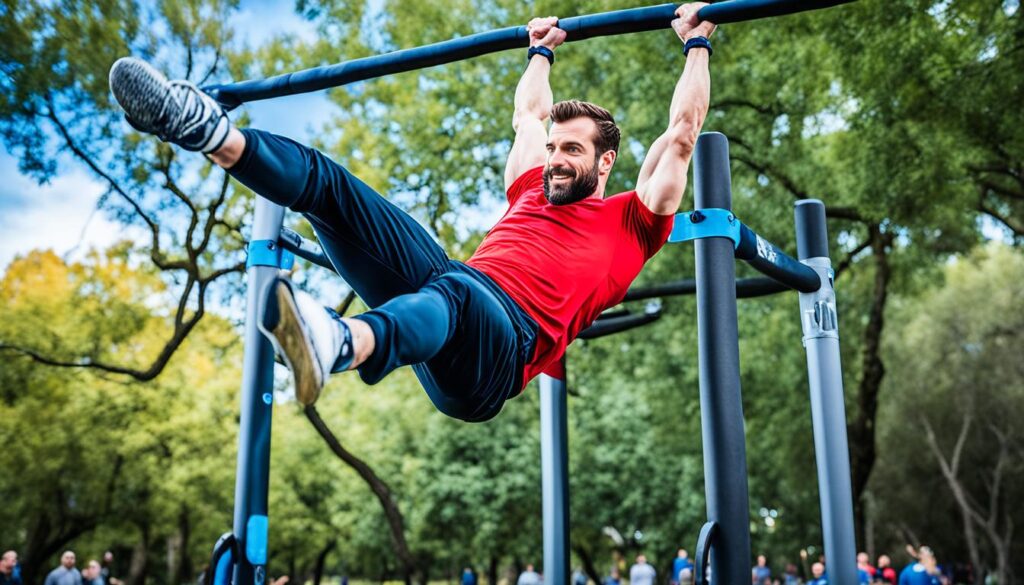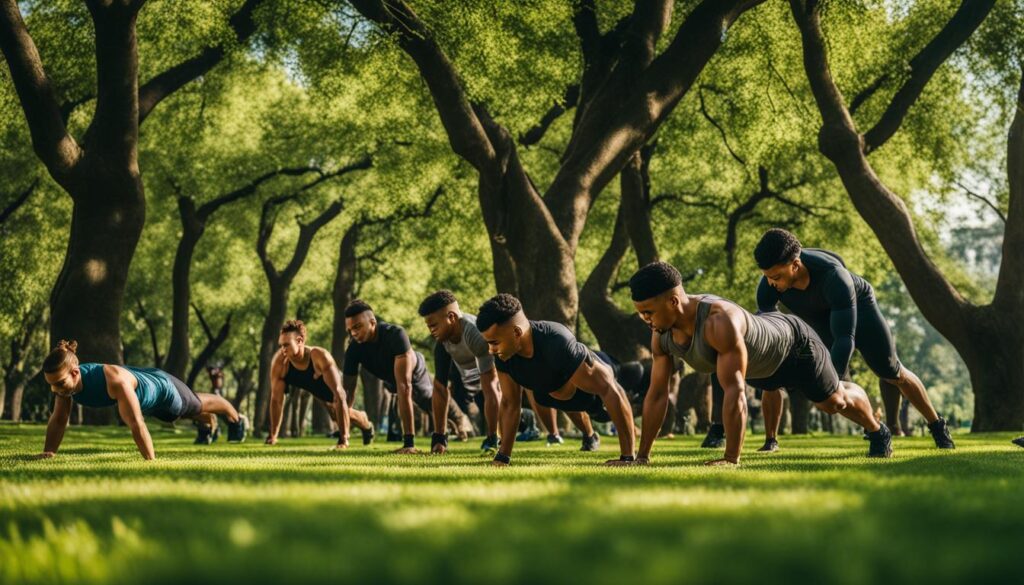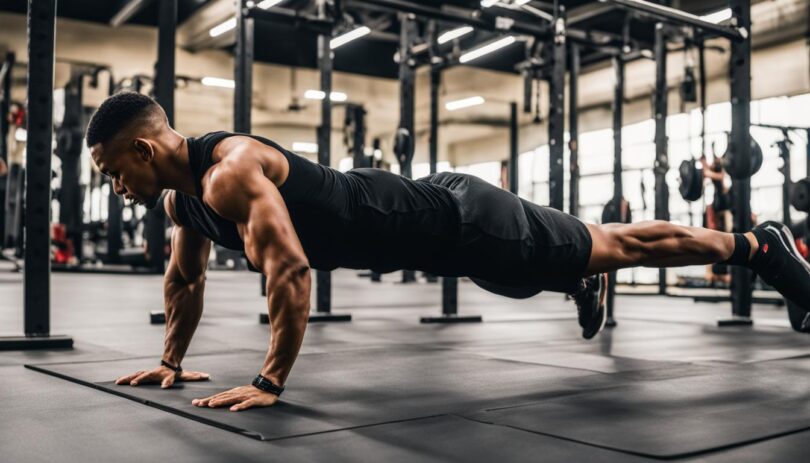If you’re looking to build muscle, you may be wondering if calisthenics can be just as effective as weightlifting. While weightlifting is a well-established method for building muscle, calisthenics and bodyweight training have become increasingly popular in recent years.
In this section, we will explore the potential for calisthenics to build muscle, compare it to weightlifting, and highlight the benefits of incorporating bodyweight exercises into your training routine. We’ll examine the mechanisms behind muscle growth and discuss ways to maximize muscle growth with calisthenics.
Key Takeaways
- Calisthenics can be as effective as weightlifting in building muscle through muscle adaptation and progressive overload.
- Bodyweight exercises have the added benefit of improving functional strength, flexibility, coordination, and cardiovascular endurance.
- The advantages of bodyweight exercises include full-body engagement and increased body control.
- Combining calisthenics and weightlifting in a training routine can offer complementary benefits for overall strength and muscle growth.
- Proper form and technique are important for maximizing muscle growth with calisthenics.
Understanding Calisthenics and Weightlifting
Calisthenics and weightlifting are two popular forms of exercise that can help you build muscle and improve your strength and overall fitness levels. While both modalities aim to increase muscle mass and strength, they differ in their approach and methodology.
Calisthenics is a form of bodyweight training that uses your own body weight as resistance to build muscle. It typically involves exercises like push-ups, pull-ups, squats, lunges, and planks, which engage multiple muscle groups at once and require no external weights or equipment.
Weightlifting, on the other hand, involves lifting external weights such as dumbbells, barbells, or kettlebells to build strength and muscle mass. It typically involves exercises like bench press, deadlifts, squats, and overhead press, which target specific muscle groups and allow for progressive overload.
While both forms of exercise can be effective for building muscle, they have different pros and cons. Calisthenics is ideal for those who prefer to work out at home or outside without access to a gym or weights. It can also be more effective for improving overall functional strength and body control, as it engages more of your muscles and requires coordination and balance.
Weightlifting, on the other hand, is ideal for those who want to target specific muscle groups and achieve greater muscle hypertrophy. It allows for more precise load manipulation, progressive overload, and intensity variation. Some experts also believe that weightlifting may lead to greater testosterone and growth hormone production, which can support muscle building.
Ultimately, the choice between calisthenics and weightlifting depends on your individual fitness goals, preferences, and access to equipment and resources. Combining both modalities in a well-rounded fitness program can also provide greater benefits.
Bodyweight Training for Building Muscle
Bodyweight training is a key component of calisthenics and can be an effective way to build muscle without external weights. By using your own body weight as resistance, you can challenge your muscles and stimulate muscle growth. Bodyweight exercises also tend to be more functional, as they simulate movements and actions that you perform in your everyday life.
Some effective bodyweight exercises for building muscle include:
- Push-Ups
- Pull-Ups
- Dips
- Squats
- Lunges
- Planks
By varying the intensity, volume, and frequency of these exercises, you can create a challenging and effective muscle building routine with calisthenics.

Muscle Building Mechanisms
To understand the muscle building process, you first need to know how your muscles work. Each muscle is made up of thousands of muscle fibers, which contract and relax to create movement. When you perform exercise that stresses your muscles, it causes microscopic damage to the muscle fibers.
During the recovery process, your body repairs and rebuilds these damaged muscle fibers, resulting in muscle growth. Both calisthenics and weightlifting can contribute to this process, but in different ways.
Weightlifting involves using external weights to increase resistance and stress on your muscles. This promotes muscle growth through the process of progressive overload, where you gradually increase the amount of weight lifted over time.

Calisthenics, on the other hand, utilizes bodyweight exercises to target specific muscle groups and improve overall functional strength. While it may not provide the same level of external resistance as weightlifting, it can still effectively stimulate muscle growth by altering the leverage and intensity of your bodyweight exercises.
To maximize muscle growth with calisthenics, it’s crucial to progress strategically through different exercise variations, rep ranges, and the intensity of your workouts. This can help challenge your muscles and ensure that they are continuously stimulated.
| Calisthenics vs Weightlifting for Muscle Gain | Calisthenics | Weightlifting |
|---|---|---|
| Resistance | Bodyweight only | External weights |
| Exercise Type | Functional movement patterns using whole body | Isolation exercises targeting specific muscle groups |
| Progression | Progression through exercise variations and intensity | Progression through increasing weight and reps |
Comparing Calisthenics and Weightlifting for Muscle Growth
While both calisthenics and weightlifting can promote muscle growth, they do so in different ways and have their respective advantages and disadvantages. One is not necessarily superior to the other, as it depends on individual preferences and fitness goals.
Calisthenics targets multiple muscle groups, provides functional training, and can be done anywhere without equipment. Weightlifting, on the other hand, allows for more precise targeting of specific muscle groups, progressive overload, and allows for greater resistance and intensity.
Benefits of Calisthenics
Calisthenics offers a wide range of benefits beyond simply building muscle. Incorporating bodyweight exercises into your fitness routine can improve functional strength, flexibility, coordination, and cardiovascular endurance. One major advantage of calisthenics is that it engages multiple muscle groups simultaneously, promoting full-body engagement and increased body control.
Here are some specific benefits of calisthenics:
- Improved joint mobility: Bodyweight exercises can help increase joint mobility, improving flexibility and reducing the risk of injury.
- Increased body control: Calisthenics exercises require a high level of body control and coordination, improving balance and stability.
- Versatile and convenient: Calisthenics exercises can be done anywhere, anytime, with minimal equipment required.
- Lower risk of injury: Because bodyweight exercises are low-impact, they place less stress on joints and reduce the risk of injury compared to heavy weightlifting.
- Improved cardiovascular endurance: Many calisthenics exercises are cardio-intensive, providing a great cardiovascular workout in addition to muscle development.

“Calisthenics is not just about building muscle, it’s about training your body to be strong and adaptable in all situations.”
Weightlifting: Traditional Muscle Building Approach
When it comes to building strength, weightlifting has been the long-standing, traditional approach. Weightlifting leverages external weights to progressively overload specific muscle groups, causing them to adapt and grow in size and strength. This approach is ideal for individuals who want to focus on strength gains and hypertrophy in targeted areas of the body.
Weightlifting allows you to target specific muscle groups with greater precision than calisthenics. By adjusting the weight and number of reps, you can progressively overload the muscles, stimulating growth and strength gains. Weightlifting is also advantageous in terms of muscle activation. Studies have shown that external weights activate muscles to a greater degree than bodyweight exercises, leading to greater hypertrophy.
Compared to calisthenics, weightlifting offers quicker and more noticeable strength gains. However, it requires access to equipment and is less convenient to perform than bodyweight exercises, making it a less practical approach for some individuals.
Overall, the decision to choose weightlifting versus calisthenics for strength gains ultimately depends on personal preferences, goals, and accessibility to equipment. Incorporating elements of both weightlifting and calisthenics can offer a more well-rounded approach to strength training.

Calisthenics for Muscle Growth
To answer the question, “can bodyweight exercises build muscle?”, the answer is a resounding yes. Calisthenics, also known as bodyweight training, is an effective method for building muscle. In fact, calisthenics can provide a more holistic approach to muscle growth by targeting multiple muscle groups simultaneously and improving overall functional strength.
Calisthenics can be used to promote hypertrophy, or muscle growth, through a process called muscle adaptation. By constantly changing the type, tempo, and intensity of bodyweight exercises, you challenge your muscles and force them to adapt to new stimuli. This, in turn, leads to increased muscle fiber recruitment and ultimately, muscle growth.
One of the benefits of calisthenics is the variety of exercises available that can target different muscle groups. For example, push-ups and dips target the chest, shoulders, and triceps, while pull-ups and chin-ups work the back and biceps. Squats and lunges target the lower body, particularly the quads and glutes, and planks and leg raises engage the core muscles.

Calisthenics Routines for Muscle Building
Designing a calisthenics routine for muscle building depends on your fitness level and goals. Here is an example of a beginner calisthenics routine:
| Exercise | Sets | Reps |
|---|---|---|
| Push-ups | 3 | 10-12 |
| Squats | 3 | 10-12 |
| Lunges | 3 | 10-12 (each leg) |
| Plank | 3 | 30-60 seconds |
This routine targets the major muscle groups of the upper body, lower body, and core. As your fitness level improves, you can increase the intensity of these exercises by modifying the exercises, increasing reps, or decreasing rest time between sets.
Overall, calisthenics is an effective approach to muscle building that offers a wide range of exercises to target different muscle groups. By utilizing the principles of muscle adaptation and progressive overload, you can design a calisthenics routine specifically tailored to your fitness goals and achieve significant muscle growth.
Training Principles for Calisthenics Muscle Growth
To maximize muscle growth with calisthenics, you need to follow specific training principles. These principles will help you increase muscle tension, stimulate muscle fibers, and encourage muscle adaptation.
Progressive Overload
Progressive overload is the key to maximizing muscle growth with calisthenics. It involves gradually increasing the resistance or intensity of your workouts to challenge your muscles. When your muscles are consistently exposed to a higher level of resistance, they will adapt and grow stronger. To apply progressive overload, you can:
- Increase the number of reps
- Increase the number of sets
- Decrease rest time between sets
- Increase range of motion
- Add weight or resistance bands
Remember to increase the resistance progressively. Avoid sudden changes that may cause injury or strain your muscles.
Exercise Variations
It’s essential to have exercise variations in your calisthenics routine. The variations challenge your muscles in different ways and prevent plateaus in muscle growth. For example, if you’re performing push-ups, you can vary your hand placement to change the focus on different muscle groups. You can also make modifications to increase the difficulty of an exercise, such as doing a one-arm push-up instead of a regular push-up.
| Exercise | Variations |
|---|---|
| Squats | Jump squats, pistol squats, Bulgarian split squats |
| Pull-ups | Chin-ups, wide grip pull-ups, commando pull-ups |
| Push-ups | Diamond push-ups, decline push-ups, one-arm push-ups |
Experiment with different exercise variations to keep your workouts challenging and exciting.
Rep Ranges
The number of reps you perform in a set can impact your muscle growth. Lower rep ranges (1-5 reps) focus on strength development, while higher rep ranges (12-15 reps) focus on endurance. For muscle hypertrophy, the ideal rep range is 8-12 reps. This range has been shown to stimulate muscle growth effectively.
Proper Form and Technique
Using proper form and technique is crucial in preventing injuries and optimizing muscle growth. Ensure you are using the correct form for each exercise to target the intended muscle group. Proper form also helps you engage your muscles fully and avoid using momentum to complete the movement. If you’re unsure about proper form, seek advice from a qualified trainer or mentor.

With these training principles in mind, you can design an effective calisthenics muscle-building routine. Incorporating progressive overload, exercise variations, rep ranges, and proper form will help you attain your muscle strength goals effectively.
Balancing Calisthenics and Weightlifting
Both calisthenics and weightlifting have unique benefits when it comes to building muscle and increasing strength. While calisthenics focuses on bodyweight exercises and functional strength, weightlifting targets specific muscle groups and allows for progressive overload using external weights. Combining these two modalities can create a well-rounded training routine that maximizes muscle growth and overall strength goals.
But how do you balance calisthenics and weightlifting in your training program?
A good approach is to alternate between calisthenics and weightlifting days. For example, you could have two or three days of calisthenics training per week, focusing on compound movements such as push-ups, pull-ups, squats, and lunges. On the other days, you could perform weightlifting exercises that complement your calisthenics routine, such as bench press, deadlift, and military press.
Why is this approach effective?
By alternating between the two modalities, you allow your muscles to recover and adapt to the specific types of stress imposed by each exercise. This helps prevent injury and allows for consistent progress in your strength goals. Additionally, combining calisthenics and weightlifting can help you break through plateaus and achieve well-rounded strength and muscle development.
Sample Calisthenics and Weightlifting Routine:

| Day 1 (Calisthenics) | Day 2 (Weightlifting) | Day 3 (Calisthenics) |
|---|---|---|
| Warm-up: | Warm-up: | Warm-up: |
| 10-15 minute jog or jumping jacks | 10-15 minute jog or jumping jacks | 10-15 minute jog or jumping jacks |
| Main Workout: | Main Workout: | Main Workout: |
| 3 sets of 10 push-ups | 3 sets of 10 bench press | 3 sets of 10 pull-ups |
| 3 sets of 10 bodyweight squats | 3 sets of 10 squats | 3 sets of 10 dips |
| 3 sets of 10 lunges | 3 sets of 10 deadlift | 3 sets of 10 leg raises |
| Cool-down: | Cool-down: | Cool-down: |
| Stretching | Stretching | Stretching |
Note: This is just a sample routine and should be adjusted based on your fitness level, goals, and preferences. Always consult with a qualified trainer before starting a new training program.
In conclusion, balancing calisthenics and weightlifting can offer a well-rounded approach to building muscle and increasing overall strength. By alternating between the two modalities and incorporating exercise variations, you can achieve efficient and consistent progress towards your fitness goals.
Conclusion
After exploring the benefits, mechanisms, and training principles of both calisthenics and weightlifting, you may be wondering whether calisthenics can build muscle as effectively as weightlifting. The answer is not a simple yes or no. Both modalities have the potential to help you build muscle, but they differ in their approach and effectiveness depending on your goals and fitness level.
If you are new to strength training or have limited access to equipment, calisthenics can be a great way to start building muscle. Bodyweight exercises can target multiple muscle groups at once, improve your overall functional strength, and enhance your body control and flexibility. However, if you want to target specific muscle groups or lift heavier weights, weightlifting may be a more effective approach.
Ultimately, the key to maximizing muscle growth with calisthenics or weightlifting is to follow sound training principles like progressive overload, exercise variations, and proper form and technique. You can also combine both modalities in your training routine to balance your muscle development and achieve overall strength goals.
So, can calisthenics build muscle as effectively as weightlifting? The answer may vary depending on your individual fitness goals and preferences. However, with dedication, consistency, and proper training, you can build a strong, lean, and muscular body with either modality.
FAQ
Can calisthenics build muscle as effectively as weightlifting?
While weightlifting is traditionally associated with muscle building, calisthenics can be just as effective in building muscle. With proper training principles, progressive overload, and exercise variations, calisthenics can target different muscle groups and promote muscle growth.
What are the benefits of calisthenics?
Calisthenics offers numerous benefits beyond muscle building. It improves overall functional strength, flexibility, coordination, and cardiovascular endurance. Bodyweight exercises engage multiple muscle groups simultaneously and improve body control. Calisthenics is a versatile and accessible form of exercise.
How does calisthenics compare to weightlifting for muscle gain?
Both calisthenics and weightlifting can contribute to muscle gain. Calisthenics emphasizes bodyweight exercises while weightlifting uses external weights. Calisthenics relies on progressive overload and exercise variations to promote muscle growth. Weightlifting allows for targeting specific muscle groups and progressive overload through increasing external weights.
Can bodyweight exercises build muscle?
Yes, bodyweight exercises can indeed build muscle. Calisthenics utilizes bodyweight exercises to target various muscle groups and promote muscle growth. By utilizing proper training principles, progressive overload, and exercise variations, one can maximize muscle growth with bodyweight exercises.
What are the training principles for calisthenics muscle growth?
To maximize muscle growth with calisthenics, several training principles should be followed. These include progressive overload by increasing reps, sets, or exercise difficulty, incorporating exercise variations to target different muscle groups, utilizing proper form and technique, and ensuring adequate rest and recovery for muscle regeneration.
Can calisthenics and weightlifting be combined in a training routine?
Yes, calisthenics and weightlifting can be successfully combined in a training routine. This allows for a well-rounded approach to muscle growth and overall strength development. Calisthenics can provide functional strength and body control, while weightlifting allows for targeting specific muscle groups and utilizing external weights for progressive overload.


Leave a Comment